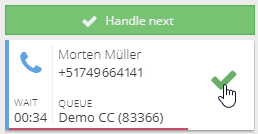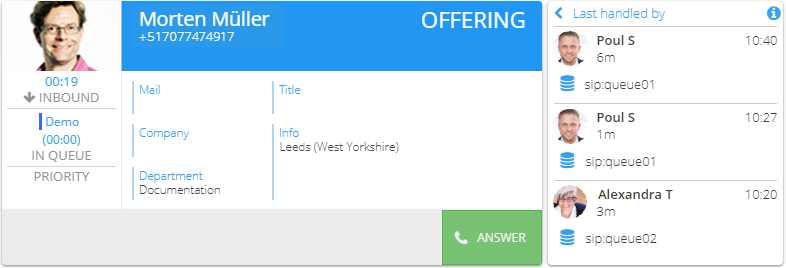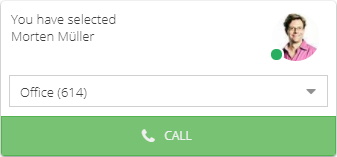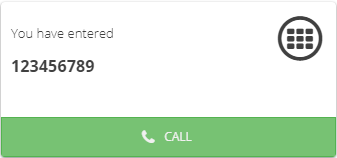Zylinc Web Agent is an upcoming product. Zylinc Web Agent hasn't been released yet, but you'll be able to get it soon.

With the Web Agent you can quickly and easily answer and handle incoming calls. You can transfer incoming calls to other people in your organization, or you can use the Web Agent to call someone.
If you work in manual mode, incoming calls will appear in the left part of your Web Agent. You can then select which call you want to answer.
If you're in automatic mode, the Zylinc solution allocates calls to you. Each call will then automatically appear in the active calls overview in the center of your Web Agent.
To answer a call in the incoming calls overview, click the right part of the card that represents the call that you want to answer.

Alternatively, select the call that you want to answer, and click Handle next.
Once you answer the call, it'll move to the active calls overview in the center of your Web Agent, from where you can handle the call further.
In the incoming calls overview, you can view how long a call has waited. Also, a colored bar will go from green (acceptable) to red (unacceptable) to give you a sense of how the call's waiting time matches the service goal.
If you work on more than one queue, remember that individual queues may have individual service goals. That can explain why calls from one queue get a red waiting time indication faster than calls from another queue.
The active calls overview in the center of your Web Agent is where you handle the calls. It's where you answer calls (if you work in automatic mode), and it's where you can put them on hold, transfer them, record them, etc.

If the caller is known to your organization, you can view:
- Which agents handled the last three calls from the caller
- Which queues handled those calls
- When the calls took place
- How long the calls lasted
To view more details about the call, such as when it began, when it entered the queue, when it was offered to you, etc. click  .
.
If your organization's Zylinc solution supports lookup, your Web Agent can automatically look up details about callers, for example account information or similar, and present it on your screen.
Ask your Zylinc administrator if you're in doubt.
If your browser window is minimized, or you're working in some other window when you get a call, the Web Agent notifies you in the bottom right corner of your screen.
To put a call on hold, click Hold.

When you have a call on hold, the button changes to Resume. Click it to resume the call that you put on hold.
If you have two calls, the button changes to Toggle. Click it to toggle between your two calls, so that you put the active call on hold and resume the other call.
You can transfer a call in two ways: Unattended (that's when you specify somebody, and then transfer the call to them without talking with them first) or attended (that's when you specify somebody, call them, talk with them, and then transfer the call to them).
-
Specify the person or number that you want to transfer the call to. You can do that in two ways:
-
Select somebody in the View people, resources, and availability in your Web Agent.
If you want to transfer the call to a colleague, you can also select an agent. However, you may not be able to call all agents, because an agent's phone type determines if you can call that agent.
-
Toggle the search field into dial mode:



Then enter the number that you want to transfer the call to.
-
-
If you want to make an unattended transfer, click Transfer.

-
Attended transfers only: If you want to make an attended transfer, click Call.

When you've talked with the person you want to transfer the call to, click Transfer.
You can view the status of your transfer in the area to the right of the active overview.
If you transfer a call to another queue, the caller will get their original waiting time credited to the next queue. Example: A caller waits for five minutes in queue 1 before you answer their call. You find out that you're not the right agent for handling the caller's inquiry, so you transfer the inquiry to queue 2. Because the caller has already waited for five minutes on queue 1, they're automatically credited with five minutes on queue 2, so that they'll go in front of other callers who've called queue 2 less than five minutes ago.
If you need to temporarily put a call aside, or if the person who should receive the call is busy, you can use the park and camp options:
-
Park: If you want to temporarily put a call aside in order to handle other calls, you can park the call.

When you park a call, the button changes to Retrieve, and the caller will hear on-hold music until you click retrieve the call.
-
Camp: If you transfer a call to someone who's busy, you can camp the call. This means that the call will wait for the person to become available. Once this happens, the person will receive the camped call automatically.

When you have camped a call, the button changes to Withdraw, so that you can take back the camped call if required.
When you camp a call, the caller can also choose to return to you. If you're busy when the camped call returns to you, the camped call will go to the front of your queue.
You may not be able to record calls in your organization.
To record a call conversation, click the REC button.

Even if you begin to record in the middle of a conversation, the call will be recorded from the beginning.
While the call is recorded, the record button is animated.
If you make an outgoing call while you record an incoming call, the outgoing call will also be recorded.
When you end the last active call, the recording automatically stops.
After the recording ends, you may be asked to provide information about why you recorded the call.
To end a call, click the END button.
After that, you'll typically go into wrapup. That's a short amount of time when you'll not receive any new calls.
To make an outgoing call, either select someone in the View people, resources, and availability in your Web Agent or simply enter the number that you want to call:
-
If you've selected someone in the availability overview, you can view your call options (for example office phone, mobile, etc.), and make the call, in the active calls overview in the center of your Web Agent.

-
To enter a number that you want to call, click the toggle button in the left side of the search field.



You can then enter a number and call it.

Many agents prefer to use keyboard shortcuts to speed up things when they handle calls.
For an overview of all such shortcuts, click  in the top right corner of your Web Agent, and then select Shortcuts.
in the top right corner of your Web Agent, and then select Shortcuts.
In the shortcuts overview, you can choose to open the complete list of shortcuts in a separate window. A list of shortcuts can be really helpful if you're new to the Web Agent.
To view your call handling history, click  in the top right corner of your Web Agent.
in the top right corner of your Web Agent.
You can forward incoming calls for specific people to someone else in the View people, resources, and availability in your Web Agent.
This is help for Zylinc version 6.0. To view Zylinc unified help for other versions, go here.
© 2021 Zylinc A/S • Disclaimer
Help version: 22 January 2021 13:21:22
Share this topic: